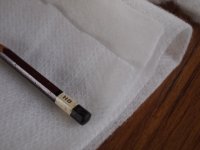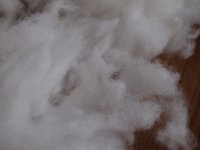dear nandape
I'm wondering if I can succeed to build your speaker box but for alpair6 (36cm2 ,. 63Hz , Vas 4,8lt , Qts 0,34). What do you think ? Should I get in to account Vas and Qts or not ?
Thanks
Elias
P.S Sorry nandappe
I'm wondering if I can succeed to build your speaker box but for alpair6 (36cm2 ,. 63Hz , Vas 4,8lt , Qts 0,34). What do you think ? Should I get in to account Vas and Qts or not ?
Thanks
Elias
P.S Sorry nandappe
Last edited:
I'm not our friend nandappe, but yes, the laws of physics dictate you should factor Qt & Vas into it if you wish to build a quality QW. Granted, you can err on the side of caution by oversizing Vb somewhat (without tuning excessively low) since you can always get rid of any excess volume you don't need -it's a lot harder to increase what doesn't exist in the first place. 😉
Dear Elias Zacharopoulos,
How about simulating TQWT (Mass-Loaded Voigt Pipe) online?
TQWT DESIGNER
It doesn't work when I use the simulator, so I design it by intuition.
I don't attach great importance to Qts and Vas.
For Alpair 6, a box for 3 "is supported. (added Width = + 10-15mm)
Error 403 (Forbidden)!!1
Error 403 (Forbidden)!!1
How about simulating TQWT (Mass-Loaded Voigt Pipe) online?
TQWT DESIGNER
It doesn't work when I use the simulator, so I design it by intuition.
I don't attach great importance to Qts and Vas.
For Alpair 6, a box for 3 "is supported. (added Width = + 10-15mm)
An externally hosted image should be here but it was not working when we last tested it.
Error 403 (Forbidden)!!1
An externally hosted image should be here but it was not working when we last tested it.
Error 403 (Forbidden)!!1
link doesn't work
Dear nandappe
NOT ONLY by intuition, BUT BY YOUR EXPERIENCE ALSO (so many many years)
unfortunately "my client has not authorized to open..... " for both of the links in your last post
Regards Elias
Dear nandappe
NOT ONLY by intuition, BUT BY YOUR EXPERIENCE ALSO (so many many years)
unfortunately "my client has not authorized to open..... " for both of the links in your last post
Regards Elias
Last edited:
Dear Elias Zacharopoulos,
Sorry, the link doesn't seem to connect.
Please follow the link below.
http://pavane.sakura.ne.jp/driftgranturismo/diyAudio/TWTD-09T-01.jpg
http://pavane.sakura.ne.jp/driftgranturismo/diyAudio/TWTD-09T-02.jpg
Sorry, the link doesn't seem to connect.
Please follow the link below.
http://pavane.sakura.ne.jp/driftgranturismo/diyAudio/TWTD-09T-01.jpg
http://pavane.sakura.ne.jp/driftgranturismo/diyAudio/TWTD-09T-02.jpg
total length very close to -10T
Dear nandappe
Thank you for your kind offer. I will give it a try. Do you believe that it worths the effort to make the back side of the box slides due to find the best point for the opening ? By the way when you wrote something about 10~15 mm wider you mean to make the box wider and experimentally reducing the width internally adding some sheets of cardboard ?
Regards
Elias
Dear nandappe
Thank you for your kind offer. I will give it a try. Do you believe that it worths the effort to make the back side of the box slides due to find the best point for the opening ? By the way when you wrote something about 10~15 mm wider you mean to make the box wider and experimentally reducing the width internally adding some sheets of cardboard ?
Regards
Elias
Last edited:
Hi Nandappe,
Thank you for sharing your drawings and thoughts.
Curious about how you arrived at the length of the horn? I’m trying to understand how it relates to the Fs of the driver?
Thank you!
P
Thank you for sharing your drawings and thoughts.
Curious about how you arrived at the length of the horn? I’m trying to understand how it relates to the Fs of the driver?
Thank you!
P
Dear Elias Zacharopoulos,
I don't think it is necessary to change the position of the opening.
The width of plus 10-15mm is just the size that alpair6 can fit.
Dear perkri,
The longer the horn, the stronger the low range, but I think that the driving force of a 4-inch driver is limited to about 200 cm.
I don't think it is necessary to change the position of the opening.
The width of plus 10-15mm is just the size that alpair6 can fit.
Dear perkri,
The longer the horn, the stronger the low range, but I think that the driving force of a 4-inch driver is limited to about 200 cm.
Hi Nandappe,
Thank you for your response!
I was under the impression that the length of the pipe, when an even fraction of the Fs of the driver - 1/4 or 1/2 wavelength - a pipe would then “resonate/oscillate” generating a stronger bass delivery - albeit not as deep?
Thank you again for sharing!
Thank you for your response!
I was under the impression that the length of the pipe, when an even fraction of the Fs of the driver - 1/4 or 1/2 wavelength - a pipe would then “resonate/oscillate” generating a stronger bass delivery - albeit not as deep?
Thank you again for sharing!
Simplifying things, the physics are that for a given pipe geometry, the longer the pipe is, the lower the tuning frequency. That does not mean it will necessarily have much output (gain) though, which is a function of geometry and total pipe volume.
Look at it like this: pick a 15in woofer. Now fix a 6ft long tube with a cross section of 1 square inch to the back of it (I know that's not physically possible, it's just a silly example to illustrate the point). It's not going to have a whole lot of useful output from that tube, right? Now remove the tube and replace it with a 12ft long tube with the same 1 square inch cross section. How much more output do you think it'll have? Right: none (for practical purposes). It will be tuned lower, but that won't in itself give you more useful output.
A pipe's resonant frequency and its harmonic modes are dependent upon its own length and geometry; those resonant modes have no relationship in themselves to the driver's own resonant frequency. If you remove the driver, that doesn't mean you have a pipe with no resonant modes, it just means you've removed the source which triggers them. Same as a trumpet: just because you don't happen to be blowing into it, that doesn't mean the pipe hasn't got innate resonant frequencies -it just means you don't happen to be exciting them at that particular moment in history. 😉 So if you take your pipe-based speaker enclosure, remove the driver, stick your head down the hole and make a noise, it will resonate at exactly the same frequencies as it will if the driver was there (assuming you have a good air-seal around your neck!). When you design a pipe, you adjust its dimensions and tuning to suit the requirements of the driver in order to obtain a desired response. It's 'just' the method by which different people design & optimise it that differs.
This is why most on-line calculators for pipes are useless. The majority take no account of the driver's actual requirements, and are mostly (a couple of exceptions) based on Fs and Sd. Which doesn't exactly give consistent results if you have two drivers of the same size and resonant frequencies, but completely different Vas and Qt values.
Look at it like this: pick a 15in woofer. Now fix a 6ft long tube with a cross section of 1 square inch to the back of it (I know that's not physically possible, it's just a silly example to illustrate the point). It's not going to have a whole lot of useful output from that tube, right? Now remove the tube and replace it with a 12ft long tube with the same 1 square inch cross section. How much more output do you think it'll have? Right: none (for practical purposes). It will be tuned lower, but that won't in itself give you more useful output.
A pipe's resonant frequency and its harmonic modes are dependent upon its own length and geometry; those resonant modes have no relationship in themselves to the driver's own resonant frequency. If you remove the driver, that doesn't mean you have a pipe with no resonant modes, it just means you've removed the source which triggers them. Same as a trumpet: just because you don't happen to be blowing into it, that doesn't mean the pipe hasn't got innate resonant frequencies -it just means you don't happen to be exciting them at that particular moment in history. 😉 So if you take your pipe-based speaker enclosure, remove the driver, stick your head down the hole and make a noise, it will resonate at exactly the same frequencies as it will if the driver was there (assuming you have a good air-seal around your neck!). When you design a pipe, you adjust its dimensions and tuning to suit the requirements of the driver in order to obtain a desired response. It's 'just' the method by which different people design & optimise it that differs.
This is why most on-line calculators for pipes are useless. The majority take no account of the driver's actual requirements, and are mostly (a couple of exceptions) based on Fs and Sd. Which doesn't exactly give consistent results if you have two drivers of the same size and resonant frequencies, but completely different Vas and Qt values.
Last edited:
Which doesn't exactly give consistent results
Maybe a 1 in 10 chabnce of getitng something ok, much less that it will be anywhere near optimum.
dave
I was under the impression that the length of the pipe, when an even fraction of the Fs of the driver - 1/4 or 1/2 wavelength - a pipe would then “resonate/oscillate” generating a stronger bass delivery - albeit not as deep?
This is based on resonant pipe theory/action: Resonances of open air columns
When it's to be vented [mass loaded], these ultra strict 'laws' no longer apply.
Consider the pioneer's Vas/1.44, Fb = Fs optimal vented alignment, i.e. no Qts' beyond the admonition in an earlier section that the driver be rated as suitable for reflex loading [T/S = < ~0.403 Qts']: How To Build Speaker Enclosures By Alexix Badmaieff & Don Davis : Free Download, Borrow, and Streaming : Internet Archive
[Qts']: [Qts] + any added series resistance [Rs]: Calculate new Qts with Series Resistor
All the tech info I need[ed] to successfully design excellent performing vented alignments of any type with nothing but measured Fs, Vas is in this section and of course coming to 'grips' with basic pipe/horn theory to do the various vented [ML] TL alignments.
In short, the differences between the pioneer's so called 'ignorance' [quite the opposite, as many inventors have found] and T/S is one of designing for the [then] prevailing needs of the app [low power at high output impedance] Vs T/S theory for the opposite with the added capability of being able to quickly prototype many solutions regardless of driver specs [plus the significant added series resistance the pioneers were stuck with] without the average 'designer' having a clue how it's done or care.
Last edited:
Ain't that the truth. T/S is great for getting the most out of the least & rapid initial simulation (accuracy depending on the quality of the data), but the pioneers approach with the typically higher acoustic efficiency IMO ultimately wins out in alignment terms if you've the time, can handle the extra bulk & sometimes reduced power-handling.
Still needs Vas though to do it right, as you point out. 😉 Most of the on-line QW calculators seem to key off L = 1/4 wave Fs (no account for taper ratio), Sm = 2.5 Sd & Av = Sd which typically isn't enough. Then again, I suppose that given the proliferation of units these days optimised for the smallest possible volume, the chances of success are higher now with that basis than they were a while back... I can't picture Olney, Olson, Novak or Thuras for that matter (I was re-reading his original patent the other day -ye gods he was good) settling for such a simplistic take. Even Voigt didn't, the 2.5 business notwithstanding.
Still needs Vas though to do it right, as you point out. 😉 Most of the on-line QW calculators seem to key off L = 1/4 wave Fs (no account for taper ratio), Sm = 2.5 Sd & Av = Sd which typically isn't enough. Then again, I suppose that given the proliferation of units these days optimised for the smallest possible volume, the chances of success are higher now with that basis than they were a while back... I can't picture Olney, Olson, Novak or Thuras for that matter (I was re-reading his original patent the other day -ye gods he was good) settling for such a simplistic take. Even Voigt didn't, the 2.5 business notwithstanding.
Last edited:
Dear Nandappe,
I wanted to build a pair of full range floorstanding speakers for a while and came across your website and youtube channel, this design is exactly what I was hoping to find.
I have to say I greatly admire your approach towards speaker building, and your generosity to share the designs in such detail.
I decided to build a pair of these using Baltic birch ply and Mark Audio MAOP 11 drivers.
I'm quite new to speaker building and wondered if you could answer a few questions about the damping material you used?
It looks like you used a small amount of very thin felt, thinner than I can find in any audio shops. What is the reason for such a small amount, and such thin material?
I understand the mass of the polyester wool is critical, is this true also for the felt?
What is the purpose of the mesh, and what kind of mesh do you use? I haven't seen this being done before.
Regards
Jules
I wanted to build a pair of full range floorstanding speakers for a while and came across your website and youtube channel, this design is exactly what I was hoping to find.
I have to say I greatly admire your approach towards speaker building, and your generosity to share the designs in such detail.
I decided to build a pair of these using Baltic birch ply and Mark Audio MAOP 11 drivers.
I'm quite new to speaker building and wondered if you could answer a few questions about the damping material you used?
It looks like you used a small amount of very thin felt, thinner than I can find in any audio shops. What is the reason for such a small amount, and such thin material?
I understand the mass of the polyester wool is critical, is this true also for the felt?
What is the purpose of the mesh, and what kind of mesh do you use? I haven't seen this being done before.
Regards
Jules
FYI/FWIW/YMMV: for those in the USA, various types of thin felt is normally at crafts shops, on-line with Michaels Arts & Crafts, Hobby Lobby, JOANN the best known.
Note that thin felt found at craft stores is polyester and provides little to no damping.
dave
dave
Last edited:
Thank you, I actually have some 15mm thick cotton damping material (recycled cotton fabric type) but it's not really felt, it's much looser. I don't know how that would affect the acoustics for this application (directly reflecting surfaces). I'm wondering if having a thinner and possibly denser damping was intentional in this build - e.g effectively damping reflections without interfering with the volume of the enclosure too much.Note that thin felt found at craft stores is polyester and provides little to no damping.
dave
Dear Julesm,
I am of the "I don't want to use sound absorbing materials" school of thought, so I either don't use them, or if I do, they are made of low density, lightweight polyester.
I do not use high-density felt, and I do not use audio sound-absorbing materials because they are too expensive.
I usually use "quilt padding with mesh" (Photo 1) and "polyester cotton" (Photo 2) for sewing.
We can also substitute quilt batting [100 yen(US$0.75), 75cm x 80cm] and aquarium filters [100 yen, 50g] (Photo 3) available at 100 yen stores in Japan.
I am of the "I don't want to use sound absorbing materials" school of thought, so I either don't use them, or if I do, they are made of low density, lightweight polyester.
I do not use high-density felt, and I do not use audio sound-absorbing materials because they are too expensive.
I usually use "quilt padding with mesh" (Photo 1) and "polyester cotton" (Photo 2) for sewing.
We can also substitute quilt batting [100 yen(US$0.75), 75cm x 80cm] and aquarium filters [100 yen, 50g] (Photo 3) available at 100 yen stores in Japan.
Attachments
That is what we use.15mm thick cotton damping material (recycled cotton fabric type) but it's not really felt, it's much looser.
dave
- Home
- Loudspeakers
- Full Range
- Tapered Wave Tube with Damp-Duct (TWTD) + Pluvia7HD


